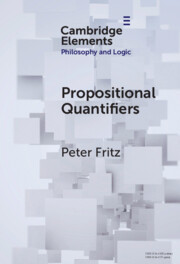Element contents
Propositional Quantifiers
Published online by Cambridge University Press: 23 April 2024
Summary
Keywords
Information
- Type
- Element
- Information
- Series: Elements in Philosophy and LogicOnline ISBN: 9781009177740Publisher: Cambridge University PressPrint publication: 16 May 2024
References
Accessibility standard: Unknown
- 10
- Cited by
